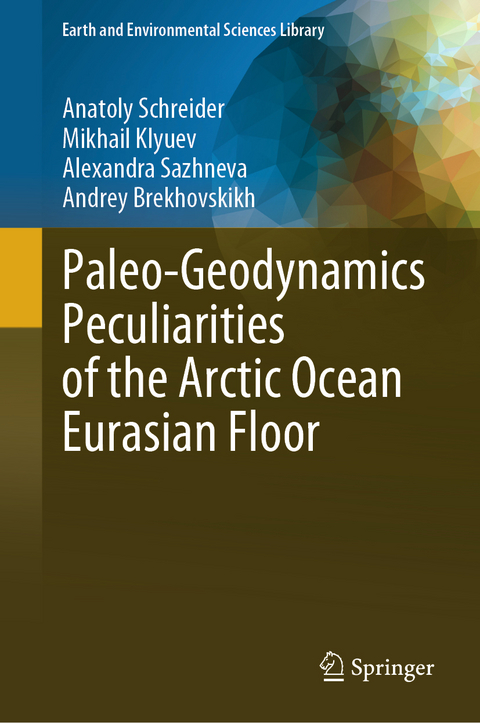
Paleo-Geodynamics Peculiarities of the Arctic Ocean Eurasian Floor
Springer International Publishing (Verlag)
978-3-031-54797-3 (ISBN)
The book deals with some issues of paleo-geodynamics of the Eurasian floor of the Arctic Ocean.
A comprehensive geological and geophysical analysis of information on the anomalous magnetic field in the Eurasian Basin was carried out using modeling of the inversion magnetically active layer of the oceanic crust. As a result of this analysis, the identification and spatial position of linear paleo-magnetic anomalies were refined, which made it possible to significantly update the geochronology of the bottom of the Eurasian Basin and identify a number of stages in its evolution.
On this basis, the features and stages of the kinematics of the development of the bottom of the Eurasian Basin in the past were revealed.
At the first Cretaceous-Paleogene stage, prior to the formation of the A26 paleo-anomaly on the Eurasian margin, extension processes developed significantly and turned into rifting. In the process of rifting, weakened zones and related fractures were formed, along which the Siberian continental margin began to be torn off about 60 Ma ago with the formation of the Lomonosov Ridge.
At the second stage of evolution, rifting turned into spreading, and the growth rate of the new oceanic crust in the A26-A24 paleo-anomaly interval (59-53 Ma ago) was more than 2.5 cm/yr. At the same time, the northern flank of the Mid-Arctic Ridge grew more intensively than the southern one.
The third stage was characterized by a further progressive slowdown in the process of bottom spreading, the minimum of which, with spreading rates of about 1 cm/year, fell on the formation of paleo-anomalies A13-A6 (30-20 million years ago).
The fourth stage of growth of the new oceanic crust began later than the time of the A6 paleo-anomaly and is characterized by some intensification of growth at rates up to 1.2 cm/yr. The average rate of bottom growth over an interval of almost 60 Ma turned out to be close to 1.3 cm/yr, which makes it possible to classify the Mid-Arctic Ridge as a slow-growing one.
On this basis, kinematic models of the development of bottom configurations were developed with the determination of the Euler poles, rotation angles, asymmetries, axes of spallation and paleo-bathymetry for the Eurasian Basin, the Polar part of the Lomonosov Ridge, the splitting of the Arlis Spura from the Lomonosov Ridge, the development of the Gakkel Ridge and the development of the Greenland region of the bottom.
Anatoly Schreider
Graduated from the Faculty of Geology of Moscow State University in 1966. Chief Researcher of the Shirshov Institute of Oceanology of the Russian Academy of Sciences, Doctor of Geology and Mineralogy, Professor. The area of scientific interests is geophysics, tectonics and geodynamics of the ocean floor, as well as the magnetic field of bottom oceanic rocks. He is a leading expert in the field of the chronological scale of linear ocean magnetic anomalies. Author and co-author of more than 200 scientific publications, including 14 collective monographs.
Mikhail Klyuev
Graduated from the Faculty of General and Applied Physics of the Moscow Institute of Physics and Technology in 1986. Senior Researcher of the Shirshov Institute of Oceanology of the Russian Academy of Sciences, Doctor of Physics and Mathematics Sciences. The area of scientific interests is the development of seismic-acoustic methods, geophysical models, interpretations and equipment for studying the structure and objects of the seabed. Applied research in marine geology, hydro-acoustics and underwater archeology. Author and co-author of more than 100 scientific publications, including 2 collective monographs.
Alexandra Sazhneva
Graduated from the Faculty of Radio Engineering Systems of the Moscow Institute of Radio Engineering, Electronics and Automation in 1995. Senior Researcher at the Institute of Oceanology of the Russian Academy of Sciences, Doctor of Technical Sciences. Area of scientific interests - paleo-geodynamics, analysis of linear magnetic anomalies of the seabed and development of kinematic models of its development. Author and co-author of about 100 scientific publications.
Andrey Brekhovskikh
Graduated from the Faculty of Geography of Moscow State University in 1975. Researcher of the Institute of Oceanology of the Russian Academy of Sciences, Doctor of Physical and Mathematical Sciences. The area of scientific interests is mathematical modeling of the hydrophysical processes of the World Ocean, modern methods of data analysis and processing, mapping of the surface and structures of the seabed. Author and co-author of more than 70 scientific publications.
Chapter 1. Geo-Chronology of the Eurasian Basin Floor.- Chapter 2. Paleo-Magnetic Anomalies in the Laptev Sea.- Chapter 3. Kinematic Model of the Eurasian Basin Floor Development.- Chapter 4. Kinematic Model of the Lomonosov Ridge Polar Part Development.- Chapter 5. Kinematic Model of the Arlis Spur Breakaway from the Lomonosov Ridge.- Chapter 6. Kinematic Model of the Gakkel Ridge Development.- Chapter 7. Kinematic Model of the Near-Greenland Floor Development.
| Erscheinungsdatum | 22.03.2024 |
|---|---|
| Reihe/Serie | Earth and Environmental Sciences Library |
| Zusatzinfo | XII, 117 p. 59 illus., 22 illus. in color. |
| Verlagsort | Cham |
| Sprache | englisch |
| Maße | 155 x 235 mm |
| Themenwelt | Naturwissenschaften ► Geowissenschaften ► Geografie / Kartografie |
| Naturwissenschaften ► Geowissenschaften ► Hydrologie / Ozeanografie | |
| Schlagworte | Arctic ocean • Bottom Geochronology • Bottom Kinematic Models • Bottom Magnetic Anomalies • Euler Poles • Eurasian Basin • Gakkel Ridge • Lomonosov Ridge |
| ISBN-10 | 3-031-54797-7 / 3031547977 |
| ISBN-13 | 978-3-031-54797-3 / 9783031547973 |
| Zustand | Neuware |
| Haben Sie eine Frage zum Produkt? |
aus dem Bereich


